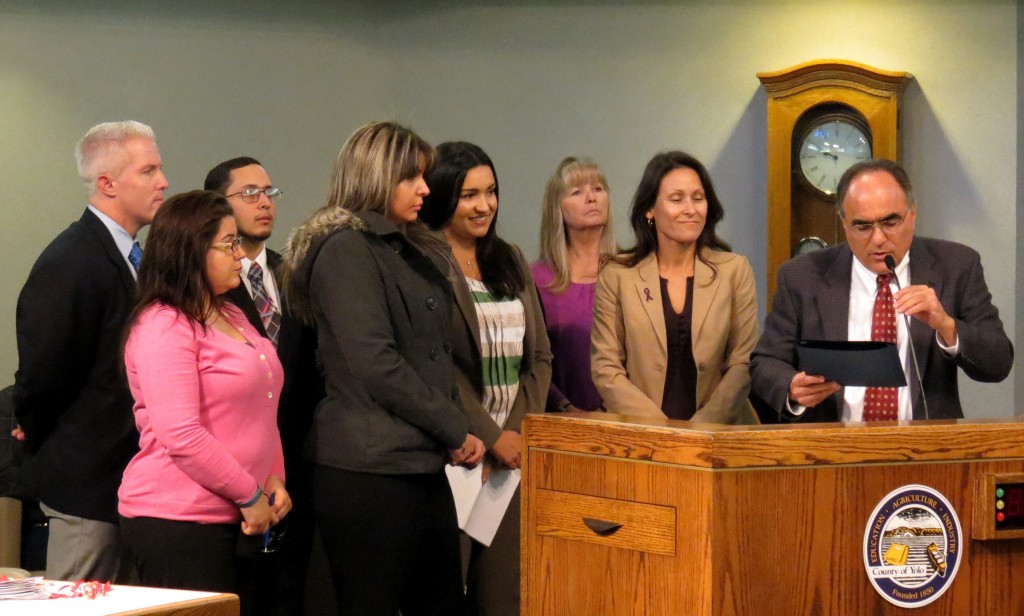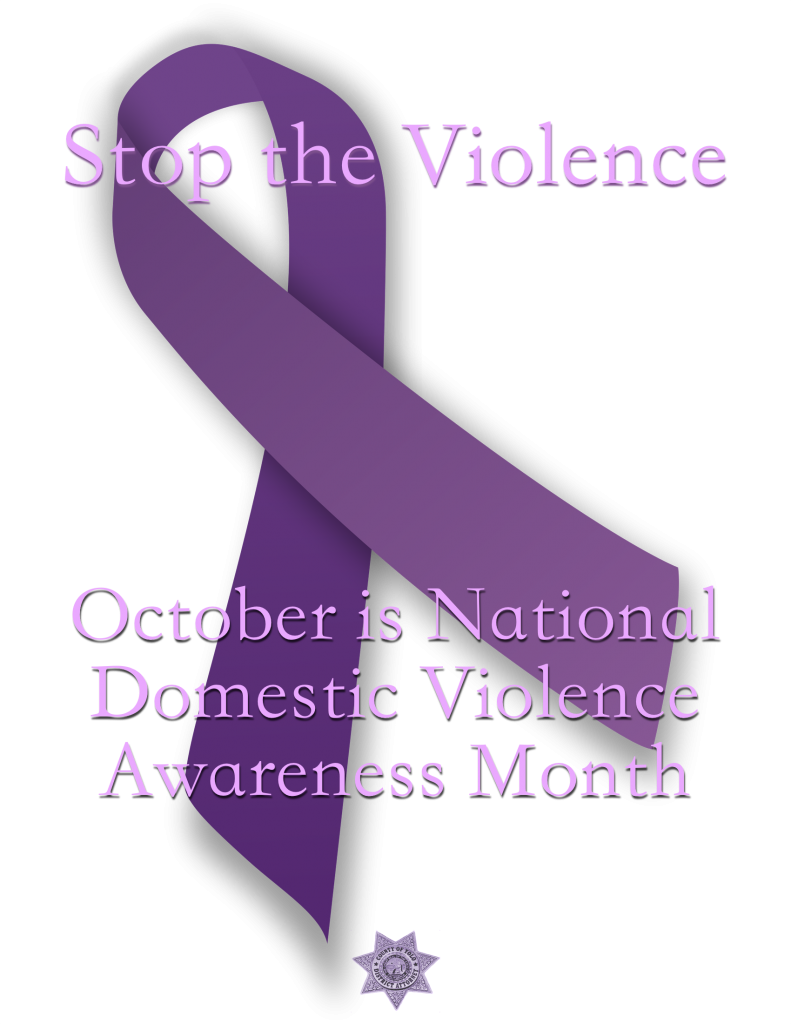
Yolo County Supervisor Jim Provenza presents a proclamation to a domestic violence survivor (pictured 4th from left) and the Yolo County District Attorney’s Office in honor of Domestic Violence Awareness. This is a month to mourn those who have died because of domestic violence; a month to celebrate those who have survived; and a month for connecting with members of our community to work to empower victims of domestic violence. Pictured also are District Attorney Jeff Reisig (far left), Deputy District Attorney Diane Ortiz (5th from left), and Victim Service’s staff.
October is Domestic Violence Awareness Month
Domestic violence can happen to anyone, anywhere, regardless of age, economic status, race, religion, nationality or educational background. It isn’t a personal matter or even a family issue, but an alarming and pervasive problem that impacts victims, abusers, family members, friends and entire communities. Despite this fact, most cases of domestic violence are never reported. The hidden nature of the crime makes it difficult for others to recognize, and instances of domestic violence are often excused, denied, concealed, or overlooked by the victim.
Domestic Violence Defined
Domestic violence (DV) is a pattern of abusive behavior committed by an intimate partner with the intent to dominate and control a victim. Domestic violence can occur in many forms including physical, sexual, emotional, psychological and economic abuse. Acts of domestic violence may be either overt (e.g. punching) or covert/passive (e.g. mind games or neglect). These acts may differ in range and severity.
Statistics and Facts
- On average, 24 people per minute are victims of rape, physical violence, or stalking by an intimate partner in the United States. Over the course of a year, that equals more than 12 million women and men. 1
- Approximately 33 million (15%) of all U.S. adults admit that they have been a victim of domestic violence.2
- Six in ten adults claim that they know someone personally who has experienced domestic violence.3
- The cost of domestic violence exceeds 5.8 billion dollars each year in the United States.4
Although anyone can be a victim of domestic violence, women are disproportionally affected:
- One in four women is the victim of severe physical violence by an intimate partner.6
- The percentage of female victims of DV is about four times that of male victims.7
- Women 18-24 years of age are at the greatest risk of nonfatal intimate partner violence.8
- Women who have been pregnant in the last five years report significantly higher rates (12%) of DV.9
Adults are not the only victims:
- One in five children (20.3%) report witnessing a family assault during their lifetime.10
- 75% of DV victims have children under the age of 18 at home.11
- 5.2% of 9th graders and 8.2% of 11th graders experience at least one incident of physical dating violence.12
Why Do Abuse Victims Stay?
One of the most perplexing questions surrounding domestic violence is why a victim chooses to stay in an abusive relationship. People who have never experienced intimate partner violence may think it incomprehensible. However, there are many reasons a victim might stay put; reasons that are rooted in strong emotional and psychological ties that are not easily broken. Victims who have suffered long term physical and emotional abuse are often in the depths of despair and paralyzed with trauma. They may be too fearful, confused or impaired to make decisions.
Domestic violence rarely ends at the time of separation from the abuser; in fact, the most dangerous period for a victim is when he or she chooses to leave the abusive relationship. Some of the reasons victims stay in abusive relationships include:
- Belief that they will not be taken seriously by family, friends, or even law enforcement
- Threats to harm, take away, or take custody of their children
- Fear of being fatally harmed by the abuser
- Anxieties of living alone
- Shame or guilt over the failure of marriage/relationship
- Economic dependency
- Lack of job skills
- Lack of housing options
- Unawareness or lack of community resources
- Emotional impairment (confusion, feeling trapped or helpless)
- Belief the abuser will change because of their remorse or promises
- Lack of emotional support
- Not understanding they are being abused. “It is normal.”
- Traumatic bonding to the abuser
- Cultural or religious beliefs
- Self-blame — feeling that they deserved to be abused
- Social isolation from friends and family as a result of the abuser’s controlling behavior
While it is important to understand why a victim stays, it is important to also ask the question, “Why does the batterer abuse?” It is very important not to place blame on victims of domestic violence and to understand that the victim needs help, not judgment.
Safety Planning
If you are in an abusive relationship and need to escape a violent environment, consider developing your own personal safety plan. A safety plan may reduce your chance of injury or even save your life. If you need help, contact your local domestic violence advocate, who can assist you in developing a viable plan and obtaining the resources you need. Leaving a batterer is one of the most dangerous times in an abusive relationship; therefore, take extra precautionary measures when exercising a safety plan.
Tips for Using Technology
Computers, phones, and other devices can be monitored by a suspicious abuser, even if you delete information from a device. Even deleting your web browsing history or changing your behavior online may arouse suspicion. Also, your cell phone may have a GPS system that your abuser can use to track you.
Be cautious. If possible, only use devices that your abuser cannot access when you research domestic violence resources or contact an advocate. For example, use a public computer at a library or purchase a prepaid cell phone.
First Steps
- Document the abuse. Take photos of your injuries, and keep a journal in safe place, such as a trusted friend’s house.
- Show your injuries to your friends or family.
- Take a picture of property damage.
- Identify exits and devise escape routes. Frequently practice your escape plan.
- When the abuse escalates and you feel your safety is jeopardized, go to a room with an exit. Never go to a room with items that could be used as weapons. Be aware that innocuous items such as a broomstick, beer can, or pen can quickly turn into a weapon in the hands of an abuser.
- Keep important phone numbers handy, including family, friends, and emergency shelters. Memorize them if possible.
- Choose a code word or signal. Inform friends, family, neighbors, and co-workers that this is your signal for them to call law enforcement.
- Teach your children to call 911 in case of an emergency.
- Purchase a prepaid cell phone and hide it in a safe place.
- Remove guns or other weapons from the house, unless this will jeopardize your safety. If so, put them in hard-to-reach places.
- Keep your car filled with gas, and park it in a position for a quick getaway.
- Open your own bank account and start saving money.
Preparing to Leave
- If you don’t have a secure cell phone, keep money available for phone calls.
- Pack a “grab-and-go bag” with essential items. Do not keep where the abuser can find it. Leave the bag with family, trusted friends, a storage rental, or in a secured area at work. Include items such as:
- Clothes
- Toiletries
- Medicine
- Copies of your keys
- Copies of important legal documents to help you obtain services and, if necessary, take legal action.
- Medical Cards
- Medical Records, Prescriptions
- Passports/Immigration papers
- Social Security Cards
- Driver’s license
- Marriage License
- Birth certificates
- Paystubs (proof of income for both parents)
- Documentation of past abuse (photos, police reports, restraining order)
- Receipts of property that has been paid
- Car title and registration
- Insurance policies
- Tax records
- Social Service papers
- Address book
- Rent receipts or mortgage papers
- Charge Cards
- Bank statements
- Check books
- Choose a time to leave. Make certain that your abuser is not home at that time.
- Contact law enforcement for assistance when you are ready to leave.
- Contact a lawyer to discuss custody issues.
- Contact Child Protective Services if you feel your children are in danger.
After Leaving an Abuser
- Get a new cell phone and a new number.
- Document all interactions involving the abuser.
- Change the locks on your house and car if you have access to them.
- Meet with a domestic violence advocate or go to a shelter.
- Avoid being alone whenever possible.
- If it is necessary to meet with your abuser, do so only in a public place.
- Change your daily routine often: your abuser may attempt to stalk you.
Get Help
Yolo County District Attorney’s Office and the Victim Services Program works in collaboration with the California Victim Compensation Program (CalVCP). CalVCP is available to assist eligible victims with crime-related expenses. Victims of domestic violence can apply for CalVCP assistance in four ways:
- Contact a local county Victim Witness Assistance Center. A victim advocate at the center can help victims complete and submit an application as well as provide other assistance. Most victim witness centers are part of the county District Attorney’s office.
- A list of California Victim Witness Assistance Centers can be found on CalVCP’s Local Help pages
- Call the CalVCP Help Line at (800) 777-9229
- Download an application from CalVCP’s How to Apply page
- E-mail CalVCP at info@vcgcb.ca.gov
The California Victim Compensation Program
National Domestic Violence Hotline
(800) 799-SAFE (7233). Help is available to callers 24 hours a day, 365 days a year.
California Partnership to End Domestic Violence
The California Partnership to End Domestic Violence promotes the collective voice of a diverse coalition of organizations and individuals, working to eliminate all forms of domestic violence.
Local County Social Services Offices
Local county social services offices can put victims in touch with financial, medical, housing and other social service assistance. For a listing of county social service offices, visit their website.
For a complete PDF of this information, including the footnotes, please download it here: Domestic Violence Awareness


